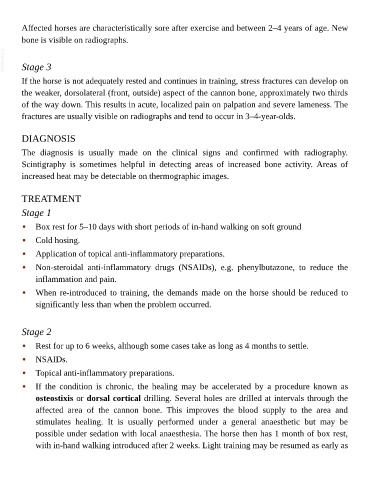Page 429 - The Veterinary Care of the Horse
P. 429
Affected horses are characteristically sore after exercise and between 2–4 years of age. New
bone is visible on radiographs.
VetBooks.ir Stage 3
If the horse is not adequately rested and continues in training, stress fractures can develop on
the weaker, dorsolateral (front, outside) aspect of the cannon bone, approximately two thirds
of the way down. This results in acute, localized pain on palpation and severe lameness. The
fractures are usually visible on radiographs and tend to occur in 3–4-year-olds.
DIAGNOSIS
The diagnosis is usually made on the clinical signs and confirmed with radiography.
Scintigraphy is sometimes helpful in detecting areas of increased bone activity. Areas of
increased heat may be detectable on thermographic images.
TREATMENT
Stage 1
• Box rest for 5–10 days with short periods of in-hand walking on soft ground
• Cold hosing.
• Application of topical anti-inflammatory preparations.
• Non-steroidal anti-inflammatory drugs (NSAIDs), e.g. phenylbutazone, to reduce the
inflammation and pain.
• When re-introduced to training, the demands made on the horse should be reduced to
significantly less than when the problem occurred.
Stage 2
• Rest for up to 6 weeks, although some cases take as long as 4 months to settle.
• NSAIDs.
• Topical anti-inflammatory preparations.
• If the condition is chronic, the healing may be accelerated by a procedure known as
osteostixis or dorsal cortical drilling. Several holes are drilled at intervals through the
affected area of the cannon bone. This improves the blood supply to the area and
stimulates healing. It is usually performed under a general anaesthetic but may be
possible under sedation with local anaesthesia. The horse then has 1 month of box rest,
with in-hand walking introduced after 2 weeks. Light training may be resumed as early as

